MSI’s GeForce N470GTX & GTX 470 SLI
by Ryan Smith on July 30, 2010 1:28 PM ESTGTX 470 SLI: Power, Temperature, & Noise
Wrapping up our look at the GTX 470 SLI, we’ll take a look at power, temperature, and noise. We have already well-established that GF100 cards can be particularly power hungry compared to their Radeon competition at similar performance levels, so this will give us a chance to see just what the situation is like when we throw multi-GPU in to the mix.
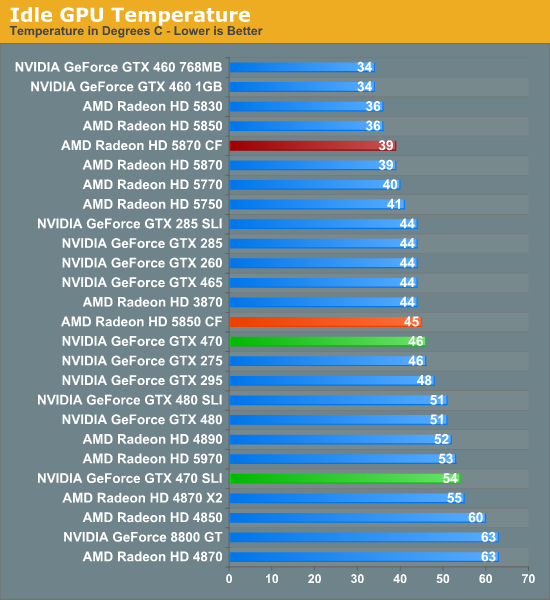
Having 2 video cards usually has a negative effect on idle conditions, and the GTX 470 SLI is no different here. Having a second card blocking the first pushes the temperatures of the first card up by 8C.
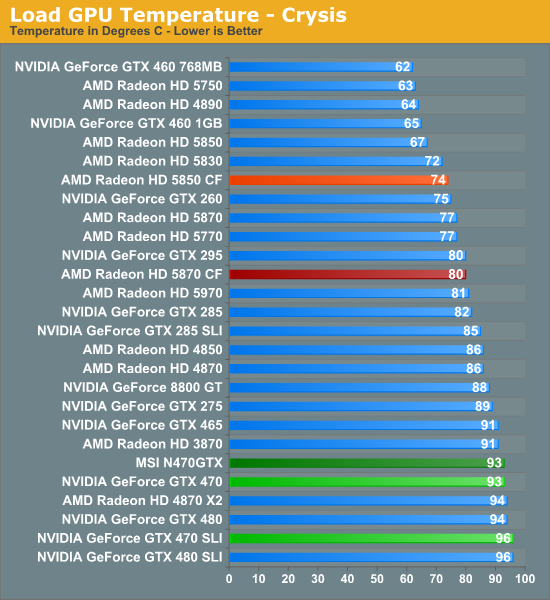
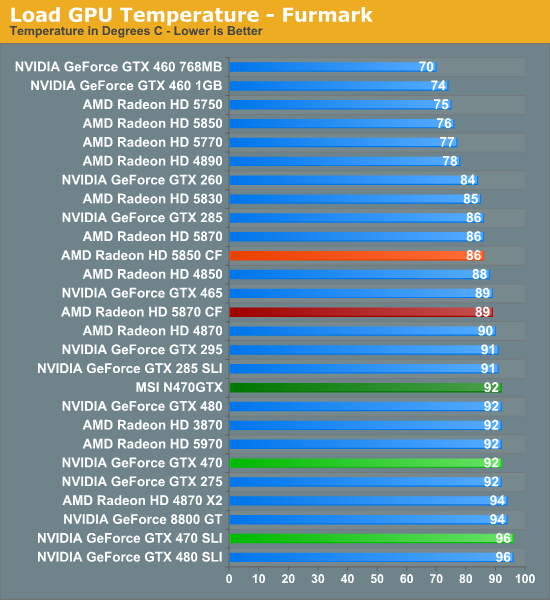
Load temperatures are similarly affected. The GTX 470 SLI ends up performing just like the GTX 480 SLI here, peaking at 96C under Crysis and stabilizing at 96C under Furmark. NVIDIA strongly suggests separating GTX 400 cards when in SLI for this exact reason – these results are when we already have a fan behind the cards. The Radeon cards do end up in a similar situation, but ultimately they still stay below 90C when in CF mode.
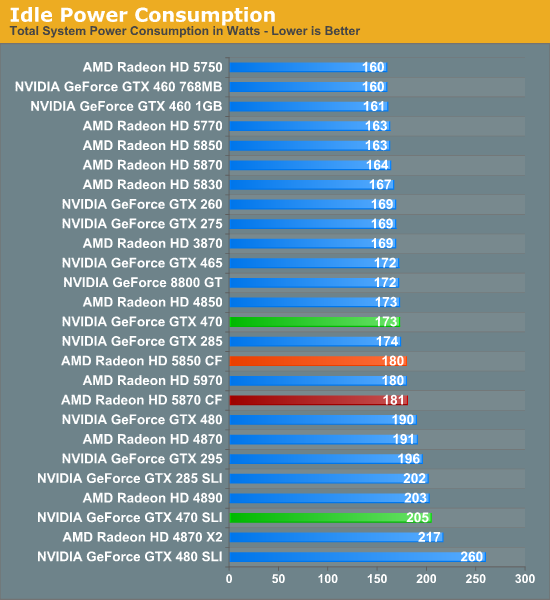
Compared to the GTX 480, the GTX 470 has noticeably lower idle power consumption, which cascades in to our SLI results. The 470 GTX SLI ends up consuming 55W less than the GTX 480 while idling, while consuming around 25W more than the Radeon cards in CF mode.
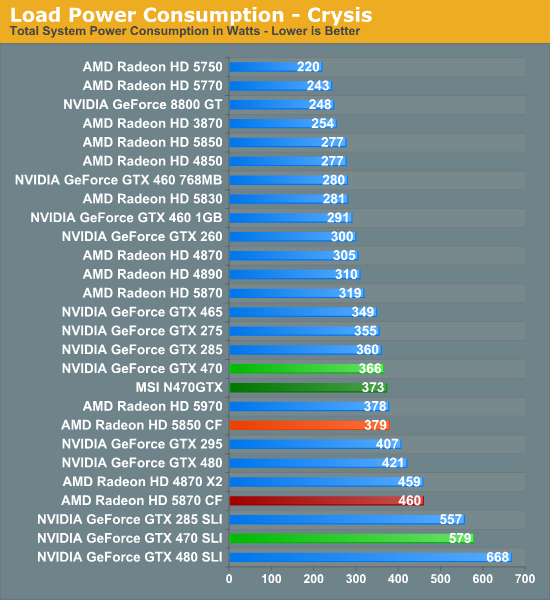
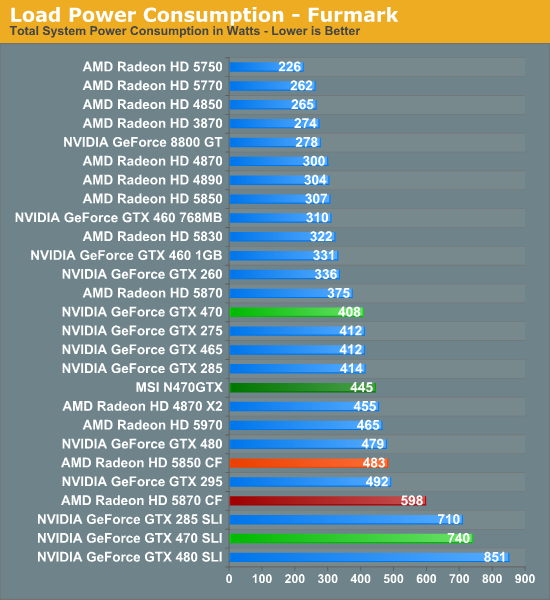
When the GTX 480 SLI became the most power hungry dual-GPU setup we’ve ever tested, there was little reason to believe that the GTX 470 SLI wouldn’t follow it, so these results shouldn’t be surprising. With Crysis the GTX 470 SLI pulls nearly 100W less than the GTX 480 SLI, but it still pulls between 100W-200W more than the Radeon cards in CF. Furmark is a similar story, but here the difference between the GTX 470 SLI and the Radeon cards is now 150W-250W.
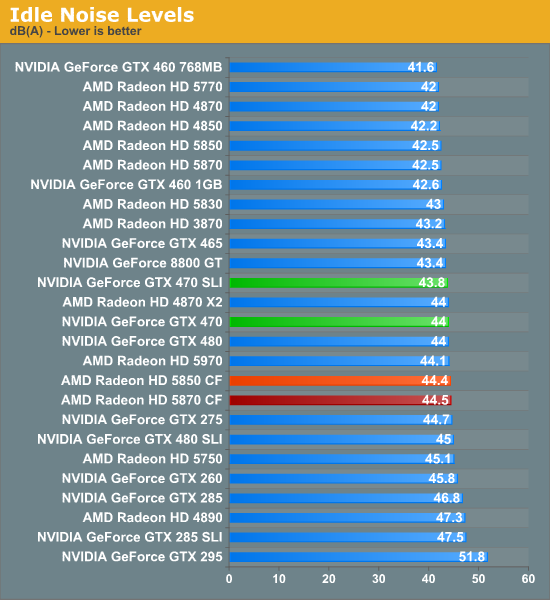
Idle noise is more or less a solved problem. The vast majority of modern coolers emit almost no noise when idling, resulting in SLI having little impact on idle noise.
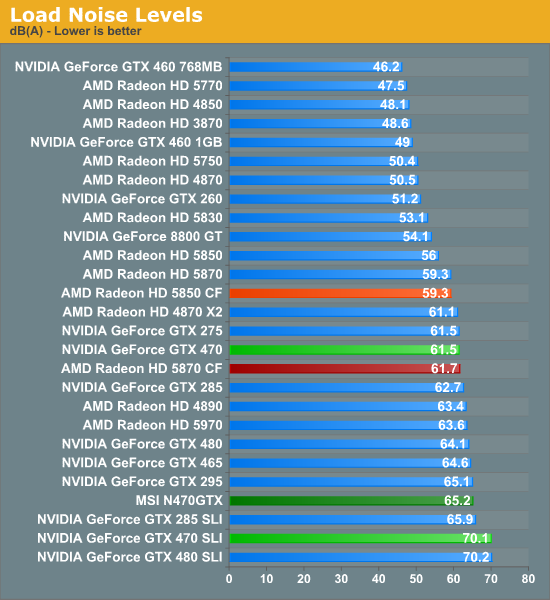
Our noise charts usually closely follow our power charts, so these results should not be surprising. With the partially obstructed GTX 470 card exceeding 90% of its top fan speed, the SLI combination is second only to the GTX 480 SLI. This is 8dB-11dB louder than the Radeon cards, and makes the GTX 470 SLI the clear winner/loser for the second-worst spot on our load noise charts.
Overall these results closely mimic what we saw with the GTX 480 SLI back when it launched: 1 GF100 card is hot & loud, and 2 cards are even hotter and louder. As the saying goes: cheap, quiet, high-performance – pick any 2.










41 Comments
View All Comments
erple2 - Saturday, July 31, 2010 - link
Normally I'd agree with you, but I think that Ryan hit the nail on the head. I can recall when NVidia and ATI were optimizing the specific internal compilers specifically for 3Dmark. Tuning for one specific engine (which is what they had to do) is very time consuming and difficult, and takes more time away from optimizing the drivers in general (or for a more "worthy" cause - another popular game).I seem to recall the optimizations were things like:
if product executable matches 3dmark.exe
then
do special tweaks that work only for the 3dmark app
else
do nothing
endif
I think that's the situation we're trying to avoid nowadays - optimizing specifically for a single executable (ultimately where you end up when you want your numbers to look "best"), hurts everything else but that one thing you're optimizing for.
There's a difference between optimizing for the API vs. the specific executable...
mapesdhs - Saturday, July 31, 2010 - link
I've spent some time trying to find out why my 8800GT SLI setup was the
same or faster than a friend's 4890 CF system. Using 3DMark06 did prove
very useful in working out the reason (shader performance). See:
http://www.sgidepot.co.uk/misc/pctests.html
http://www.sgidepot.co.uk/misc/stalkercopbench.txt
Thus, though I agree with Ryan about the dangers of GPU makers
optimising for these metrics, they can be revealing sometimes, in my
case coming to the conclusion that, if one is still playing older games,
then buying a newer card might not give that much of a speedup since
the newer design may focus on newer features.
What about including the Vantage results as a point of interest, kindof
a 'by the way' addition, but downplaying the importance of such data?
Focus on the game results, but include Vantage as an 'appendix' in
terms of presentation.
Ian.
Porksmuggler - Monday, August 2, 2010 - link
Wait, you're trying to find out why your 8800GT SLI is faster than 4890CF? You need to look elsewhere than the GPUs, 8800GT SLI is not even as fast as 4850 CF, I have both on otherwise identical setups. Your links show testing of just 3DMark06, and you tested with two entirely different systems?Ryan is spot on, don't use synthetic benchmarks to compare similar generation GPUs. They are primarily used for testing when the GPU is the constant.
It seems from the replies above there is confusion about how the coding/engine of a synthetic benchmark (so-called? really?) is very different from actual games. Reviewers do far better with a battery of games, as Anandtech uses for their articles.
imaheadcase - Saturday, July 31, 2010 - link
Thats listed in THE TEST, but its excluded from graphs.Would like to compare that to it, considering upgrading to this card from that.
anactoraaron - Saturday, July 31, 2010 - link
Yeah I noticed that also. More importantly I'd like to see 2 of those in SLI along with 2 5770s in CF. I think the 2 5770's in CF has been the best bang for your buck for awhile now, especially 2 can be had for $270AR. As I recall, the 5770 (single card setup) was ~5% less than what a 260 core 216 would get you but it was cheaper (about $30 less ATM at newegg). If you have the ability to do CF/SLI having 2 lower priced cards makes the 460/470 & 5850 decision easy IMO. However since SLI scales performance better it would be interesting to see if the added $60 for 2 260's is justified against 2 5770's.Maybe for the next article?
Kyanzes - Saturday, July 31, 2010 - link
MORE minimum frame rate measurements in the articles please!!! That's the whole essence of it! Ofc, for sheer comparison, max FPS could also be included for sure, but the MIN FPS is the real interesting part.Keep it up pls!!!!
One of the reasons I tend to check out HardOCP is that they include MIN FPS.
Please, please do it often. Do it every time.
Tunnah - Saturday, July 31, 2010 - link
awesome review as usual but how come the focus on the 470 ? i thought with the release of the 460 the 470 was kind of like..its the core i7 940 to the 920 - sure it's faster but the price difference doesn't warrant the minor speed bump, and it OC's like a dreamalso, from what i've read the 460 has amazing scaling with SLI..and the temperatures are better
but this is just what i've read in 1 review so waiting to read it here before i start to believe it :D
ggathagan - Saturday, July 31, 2010 - link
RTFA3rd sentence:
"As part of a comprehensive SLI & CrossFire guide we’re working on for next month we needed a second GTX 470 for testing GTX 470 SLI operation, and MSI answered our call with their N470GTX."
Tunnah - Saturday, July 31, 2010 - link
yeah i read it, was just saying it seemed a little redundant to do a full article on an overpriced card that was being overshadowed by a cheaper, newer revisionMatrices - Saturday, July 31, 2010 - link
The 460 numbers are still there, so what's to complain about?And the 470 can be had for $275 now rather than the $350 MSRP.
If you actually read the benchmarks, you'd see that it's hardly 'overshadowed' by the 460 on performance. It's noticeably faster in more demanding titles.